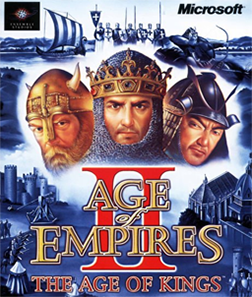Thursday, August 19, 2010

The Age of Kings focuses on building towns, gathering resources, creating armies, and destroying enemy units and buildings. Players conquer rival towns and empires as they advance their own civilization through four "Ages": the Dark Age, the Feudal Age, the Castle Age (The Middle Age), and the Imperial Age, reminiscent of the Renaissance—a 1000 year timeframe. Progressing to a new Age unlocks new units, structures and technologies, but players must pay a sum of resources and construct certain buildings before advancing.
Players choose to play as one of 13 civilizations split into four architectural styles, West European, Central European, Middle Eastern, and Far Eastern, that determine building appearance in-game. The civilizations have varying strengths and weaknesses with regards to economics, technology, and battle, and each has access to a different, very powerful "Unique Unit". To add variety, each civilization has a set of soundbites in its native language that are uttered by units when selected and instructed to perform a task.
Players choose to play as one of 13 civilizations split into four architectural styles, West European, Central European, Middle Eastern, and Far Eastern, that determine building appearance in-game. The civilizations have varying strengths and weaknesses with regards to economics, technology, and battle, and each has access to a different, very powerful "Unique Unit". To add variety, each civilization has a set of soundbites in its native language that are uttered by units when selected and instructed to perform a task.
Civilian units, called "villagers", are used to gather resources. These resources can be used to train units, construct buildings, and research technologies, among other things. The game offers four types of resources: food, wood, gold, and stone. Food is obtained by hunting animals, gathering berries, harvesting livestock, farming, and fishing. Wood is gathered by chopping down trees, gold is obtained from either gold mines, trade or having a relic in a monastery, and stone is collected from stone mines. Villagers require checkpoints, typically depository buildings, where they can store gathered resources. Each civilization can purchase upgrades that increase the rate of gathering these resources. Players who construct a special building, the market, may acquire or sell resources for gold. Market prices fluctuate with every transaction.
There are five campaigns in The Age of Kings, containing historically-based scenarios such as Genghis Khan's invasion of Eurasia, Barbarossa's Crusade, or Saladin's defence of the Holy Land. In the Joan of Arc and William Wallace campaigns, the player can control a unit based on its namesake; in others, players take orders from guiding spirits representative of the army's commander.
Additional game modes are available to the player in The Age of Kings. One mode, random map, generates a plain map, with players starting in the Dark Age with a Town Center, three villagers, and a scout unit. The game can be won through military conquest, by constructing a special building known as a Wonder and keeping it standing for a certain amount of time, or by obtaining control of all relics on the map for a set amount of time. Deathmatch mode allows players to begin with large amounts of resources, creating a focus on military dominance, while in the regicide mode each player is given a king unit, winning by killing all of the other monarchs.
Civilizations
Within a single game, the player can choose to represent one of these civilizations: Briton, Byzantine, Celtic, Chinese, Franks, Gothic, Japanese, Mongol, Persian, Saracen, Teutons, Turks, or Viking. These civilizations are divided into four types, Western Europe, Eastern Europe, Asian and Middle Eastern.
Within a single game, the player can choose to represent one of these civilizations: Briton, Byzantine, Celtic, Chinese, Franks, Gothic, Japanese, Mongol, Persian, Saracen, Teutons, Turks, or Viking. These civilizations are divided into four types, Western Europe, Eastern Europe, Asian and Middle Eastern.
Units
A Celtic player in the Feudal Age. Their Town Center is visible and has several farms surrounding it; villagers of both genders work there and elsewhere to gather resources. A scout on horseback is also at the ready. Military buildings such as the barracks, archery range, and stable are visible, as well as economic buildings — the market and mill. The south east corner of the screenshot shows the player's walls and a gate.
Every player has a limit to the number of units they can create—a population limit—but may not immediately use the entire potential population. The population capacity, which can be capped at anywhere between 75 - 200, is based on the number of houses, Castles, or Town Centers—the main building in a player's town—which have been built. The Age of Kings introduced two significant new features for unit management: the idle villager button, which helps players identify villagers that have not been assigned a task (this could be done in Age of Empires: The Rise of Rome expansion by pressing the period key after patch 1.0a), and the town bell, which sends all a player's villagers into their Town Center, Castle or tower for safety.
The Age of Kings also includes five types of military units: infantry, archers, cavalry, siege weaponry, and naval units. Certain types of infantry, archers, and cavalry are "counter units" with special defenses against other types of unit. The three human classes of military generally follow a rock-paper-scissors model. For example, infantry are generally powerful against buildings but weak against cavalry, thus, the infantry counter units—spearmen and pikemen—have attack bonuses against cavalry. The monk is a special kind of military unit that has the ability to convert enemy units to the player's civilization, and to heal allied units. Monks are also used to collect relics; relics give a player accumulative gold, the more relics he has captured, the faster the gold is put into the player's stockpile. Collecting all five relics on the map is one method by which a player can win a random map game, depending on the victory setting.
A Celtic player in the Feudal Age. Their Town Center is visible and has several farms surrounding it; villagers of both genders work there and elsewhere to gather resources. A scout on horseback is also at the ready. Military buildings such as the barracks, archery range, and stable are visible, as well as economic buildings — the market and mill. The south east corner of the screenshot shows the player's walls and a gate.
Every player has a limit to the number of units they can create—a population limit—but may not immediately use the entire potential population. The population capacity, which can be capped at anywhere between 75 - 200, is based on the number of houses, Castles, or Town Centers—the main building in a player's town—which have been built. The Age of Kings introduced two significant new features for unit management: the idle villager button, which helps players identify villagers that have not been assigned a task (this could be done in Age of Empires: The Rise of Rome expansion by pressing the period key after patch 1.0a), and the town bell, which sends all a player's villagers into their Town Center, Castle or tower for safety.
The Age of Kings also includes five types of military units: infantry, archers, cavalry, siege weaponry, and naval units. Certain types of infantry, archers, and cavalry are "counter units" with special defenses against other types of unit. The three human classes of military generally follow a rock-paper-scissors model. For example, infantry are generally powerful against buildings but weak against cavalry, thus, the infantry counter units—spearmen and pikemen—have attack bonuses against cavalry. The monk is a special kind of military unit that has the ability to convert enemy units to the player's civilization, and to heal allied units. Monks are also used to collect relics; relics give a player accumulative gold, the more relics he has captured, the faster the gold is put into the player's stockpile. Collecting all five relics on the map is one method by which a player can win a random map game, depending on the victory setting.
Buildings
Buildings in The Age of Kings are either economic, military or defensive in nature. Buildings can research technologies and upgrades that increase economic, military or unit-based efficiency, as well as provide resources for the player. The most important economic building is the Town Center, where villagers are created, all types of resources can be stored, some technologies are researched, and the player can advance to the next Age. The Town Center can fire arrows at enemy units within range if villagers or archers are garrisoned while under attack. Other economical buildings available include storage buildings for resources, farms and houses to support a higher population.
Military units are created at military buildings, such as barracks, archery ranges, stables, and docks (the dock may also produce several non-combat units). Military buildings can perform research to improve the abilities of military units, increasing their strength, defensive capabilities, or other attributes. The castle is a military building which can train a wide variety of units, including the civilization's 'Unique Unit', and fires arrows at enemy units within range, with garrisoned units firing extra arrows. It can only be built after a player has reached the Castle Age.
There are two main defensive buildings, the wall and the tower. The two types of walls, stone walls and the weaker palisades, are used to prevent access to an enclosed area whilst providing a solid line of defense. Gates can be installed in walls to allow allied units to access a defended area. Towers are equipped with the ability to fire arrows at unfriendly units, and can be used in conjunction with the wall in defense mechanisms.
Buildings in The Age of Kings are either economic, military or defensive in nature. Buildings can research technologies and upgrades that increase economic, military or unit-based efficiency, as well as provide resources for the player. The most important economic building is the Town Center, where villagers are created, all types of resources can be stored, some technologies are researched, and the player can advance to the next Age. The Town Center can fire arrows at enemy units within range if villagers or archers are garrisoned while under attack. Other economical buildings available include storage buildings for resources, farms and houses to support a higher population.
Military units are created at military buildings, such as barracks, archery ranges, stables, and docks (the dock may also produce several non-combat units). Military buildings can perform research to improve the abilities of military units, increasing their strength, defensive capabilities, or other attributes. The castle is a military building which can train a wide variety of units, including the civilization's 'Unique Unit', and fires arrows at enemy units within range, with garrisoned units firing extra arrows. It can only be built after a player has reached the Castle Age.
There are two main defensive buildings, the wall and the tower. The two types of walls, stone walls and the weaker palisades, are used to prevent access to an enclosed area whilst providing a solid line of defense. Gates can be installed in walls to allow allied units to access a defended area. Towers are equipped with the ability to fire arrows at unfriendly units, and can be used in conjunction with the wall in defense mechanisms.
Multiplayer
The Age of Kings supports multiplayer over the Internet, or via a local area network (LAN). Up to eight players can take part in one game, with all of the single player game modes available. The MSN Gaming Zone supported the game until the service closed on June 19, 2006. Alternative services, such as GameSpy Arcade, were recommended as a replacement. Currently Macintosh versions of the games seem to only be supported by the GameRanger client.
The Age of Kings supports multiplayer over the Internet, or via a local area network (LAN). Up to eight players can take part in one game, with all of the single player game modes available. The MSN Gaming Zone supported the game until the service closed on June 19, 2006. Alternative services, such as GameSpy Arcade, were recommended as a replacement. Currently Macintosh versions of the games seem to only be supported by the GameRanger client.
FREE FULL VERSION PC GAMES PARTS SYSTEM REQUIREMENTS
* Microsoft® Windows® XP
* PC with 1.4 Ghz equivalent or higher processor that supports SSE
* 256 MB of system RAM
* 2.0 GB available hard disk space
* 32x speed or faster CD-ROM drive
* 64 MB video card with HT&L
* Sound card with speakers or headphones
* Microsoft Mouse or compatible pointing device
* 56.6 Kbps or better modem for online play
* DirectX 9.0c or above
* PC with 1.4 Ghz equivalent or higher processor that supports SSE
* 256 MB of system RAM
* 2.0 GB available hard disk space
* 32x speed or faster CD-ROM drive
* 64 MB video card with HT&L
* Sound card with speakers or headphones
* Microsoft Mouse or compatible pointing device
* 56.6 Kbps or better modem for online play
* DirectX 9.0c or above
FREE FULL VERSION PC GAMES PARTS INSTRUCTIONS
MU or 7zip Password is j@ck or jack@tehparadox.com
1. Extract iso with winrar or 7-zip
2. mount iso in daemon tools, alcohol 120 or poweriso
3. install the game
4. play and enjoy
FREE FULL VERSION PC GAMES PARTS
0 Comments:
Subscribe to:
Post Comments (Atom)







